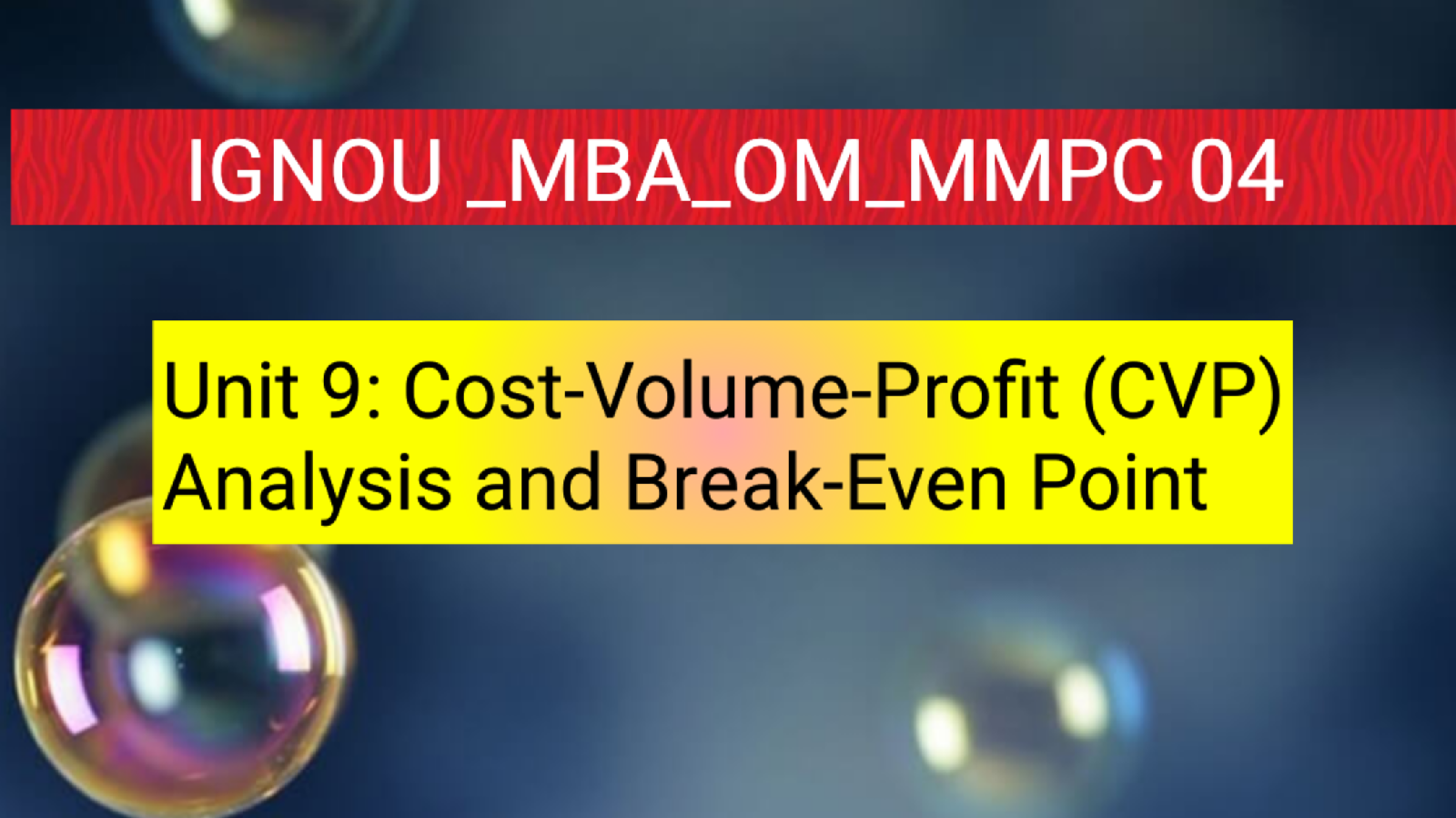Class 9: IGNOU MBA – MMPC 004: Accounting for Managers
Unit 9: Cost-Volume-Profit (CVP) Analysis and Break-Even Point
Overview of Unit 9:
Unit 9 covers Cost-Volume-Profit (CVP) Analysis and the Break-Even Point. These concepts are fundamental for understanding how various cost structures, sales volumes, and prices affect a company’s profitability. CVP analysis helps in making decisions related to pricing, product mix, and profit planning.
Topics Covered in Unit 9:
9.1 Introduction to Cost-Volume-Profit (CVP) Analysis
CVP analysis is a managerial tool used to determine how changes in costs and volume affect a company's operating profit. It is used for:
- Planning and Decision-Making: Helping management decide on product pricing, sales mix, and cost control.
- Profit Planning: Identifying the sales volume needed to achieve desired profitability.
Key Elements of CVP Analysis:
- Fixed Costs (FC): Costs that remain constant, regardless of the production volume (e.g., rent, salaries).
- Variable Costs (VC): Costs that vary directly with the level of production (e.g., raw materials, direct labor).
- Contribution Margin (CM): The difference between sales revenue and variable costs. It indicates how much revenue is contributing toward covering fixed costs and generating profit.
9.2 Break-Even Point (BEP)
The Break-Even Point is the sales level at which total revenue equals total costs, resulting in neither profit nor loss. It helps in understanding how much a company must sell to cover its costs.
Break-Even Point Formula:
Example:
- Fixed Costs (FC): ₹1,00,000
- Selling Price per Unit (SP): ₹100
- Variable Cost per Unit (VC): ₹60
This means the company needs to sell 2,500 units to break even.
9.3 Margin of Safety
The Margin of Safety represents how much sales can drop before the company reaches the break-even point. It is a measure of risk and is calculated as:
Example:
- Actual Sales: ₹5,00,000
- Break-Even Sales: ₹3,00,000
This means that sales can fall by 40% before the company starts incurring a loss.
9.4 Applications of CVP Analysis
CVP analysis is useful in various decision-making scenarios:
- Pricing Decisions: Helps in determining the impact of different pricing strategies on profitability.
- Product Mix Decisions: Assists in analyzing the profitability of different products and deciding which products to focus on.
- Cost Control: Enables managers to understand the impact of fixed and variable costs on overall profitability and to take measures for controlling costs.
9.5 Assumptions of CVP Analysis
- Linear Cost and Revenue Functions: It assumes that costs and revenues change at a constant rate.
- Constant Selling Price: Assumes that the selling price per unit does not change with volume.
- Constant Variable Cost per Unit: Assumes that the variable cost per unit remains constant regardless of production volume.
- Fixed Costs are Constant: Assumes that fixed costs remain constant over the relevant range of activity.
9.6 Limitations of CVP Analysis
- Simplistic Assumptions: Assumes linearity in costs and revenues, which may not always hold true in real-world scenarios.
- Single-Product Analysis: Often applies to a single product or uniform product mix, making it less applicable for companies with diverse product lines.
- Ignores Non-Financial Factors: Focuses purely on financial metrics and does not take into account market conditions, competition, and customer preferences.
Experiments and Real-Life Examples
- Experiment: Perform a CVP analysis for a small business. Calculate the break-even point and analyze the impact of increasing the selling price or reducing variable costs.
- Real-Life Example: Apply CVP analysis to a retail store selling electronics. Determine the break-even sales volume for different products like mobile phones and laptops, and evaluate the effect of discounts on profitability.
Assignment Questions
- Define Cost-Volume-Profit (CVP) analysis and explain its importance in decision-making.
- What is the break-even point, and how is it calculated? Provide a detailed example.
- Explain the concept of the margin of safety and its significance in risk management.
Self-Study Questions
- How does CVP analysis help in pricing decisions?
- What are the key assumptions underlying CVP analysis? How do these assumptions limit its applicability?
- Discuss the relationship between fixed costs, variable costs, and the break-even point.
Exam Questions
- Calculate the break-even point for a company with fixed costs of ₹3,00,000, a selling price of ₹150 per unit, and variable costs of ₹80 per unit.
- What is the margin of safety? Explain its importance in business risk assessment.
- Discuss the limitations of CVP analysis. How can managers address these limitations in decision-making?
Conclusion
In this class, we have covered Cost-Volume-Profit (CVP) Analysis and the Break-Even Point, both of which are essential tools for managers in making financial and operational decisions. These concepts help in understanding the relationship between costs, volume, and profit, guiding decisions on pricing, product mix, and cost control. CVP analysis is crucial for profit planning and risk management, despite its limitations in simplifying real-world complexities.





















